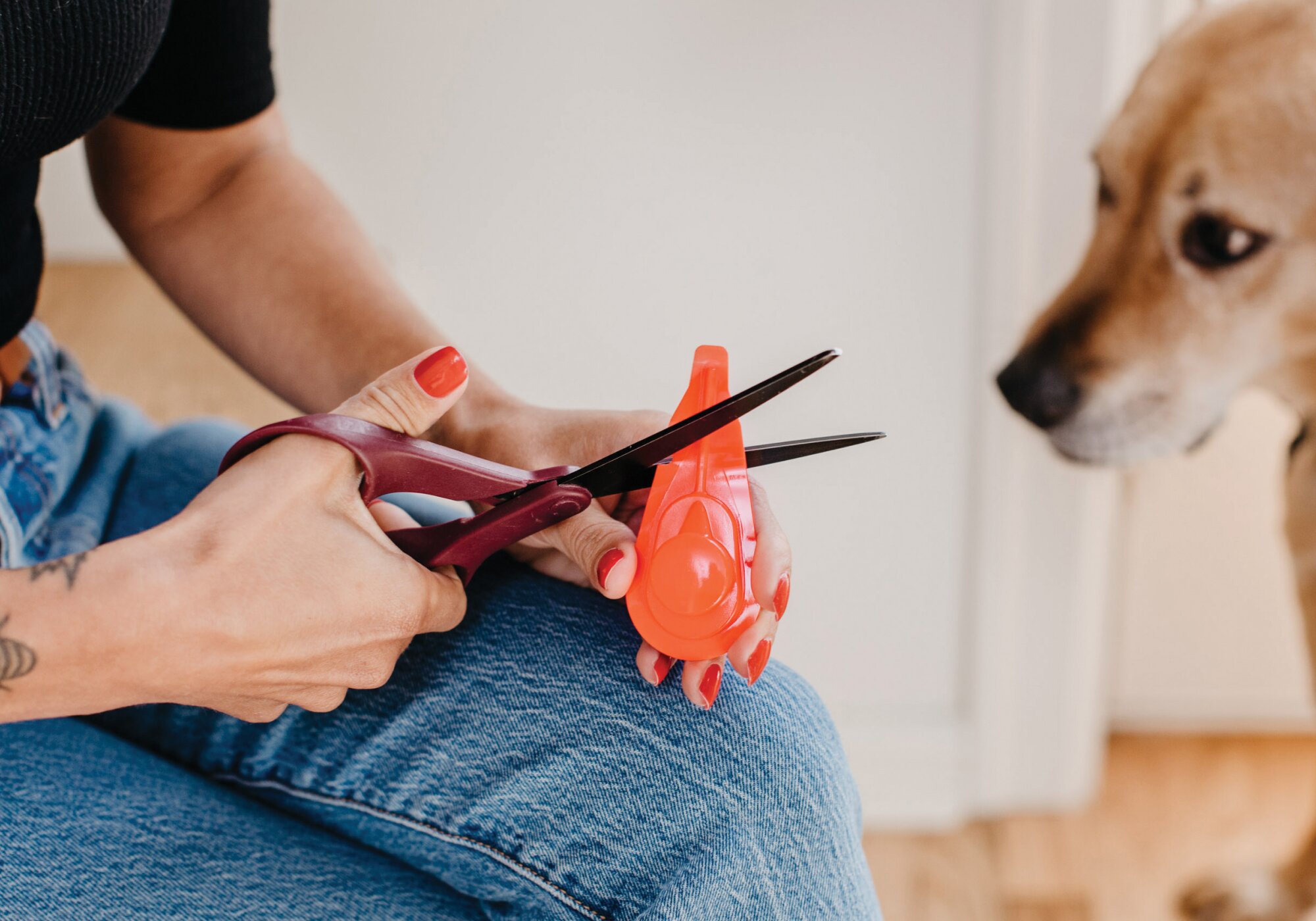When you have a flea problem, you want them gone immediately! And scouring the internet for articles and solutions can feel overwhelming. Especially with so much information out there.
In this article, we'll bust myths about fleas on dogs and share the facts to gain flea freedom once and for all.
Here are 9 common misconceptions about fleas and how to actually get rid of them.
Myth 1: It’s a quick process.
Many flea prevention products claim to have fast-acting solutions that take care of your flea problem right away. But the reality is, no product can completely solve your flea problem in a few hours or days.
In fact, the effects of fleas may last weeks after you first find fleas. Your pet may experience symptoms like itching, hair loss, and skin irritation for several weeks after a flea infestation.
Fact: Getting rid of fleas takes time.
It can take up to 90 days to completely break the flea life cycle. When a female flea feeds on your pets, they can lay 50 eggs per day or more on your pet that can disperse throughout your home. Left untreated, fleas can remain in your home for up to a year.
Don't give up if you've started treating your pets and aren't seeing instant results. Stay the course, follow instructions for getting rid of flea infestations, and contact your veterinarian for help.
Myth 2: Bathing pets takes care of all fleas issues.
There are tons of articles out there that advertise using Dawn to remove fleas from pets. And there are lots of bath-related solutions out there, including:
- Dawn or other degreasing dish soap
- Flea and tick shampoo
- Flea baths
- Flea dip
- Human or baby shampoo
But, these solutions are immediate and temporary.
When you bathe your pet, fleas rise to the surface and jump off your pet in an attempt to survive. Seeing fleas evacuate your pet's fur right before your eyes may feel like instant success, but it won't take care of your problem for good.
Fact: Bathing your pets can delay your progress.
Dawn, flea shampoo, and even plain water may help remove adult fleas and flea dirt embedded in your pet's coat. But, the likelihood that you're only dealing with adult fleas and their feces is small. Flea eggs, larvae, and other full-grown fleas may be living in your pet's bedding, toys, and nearby furniture or carpets.
If you’ve applied a topical flea treatment to your pet using a degreasing dish soap like Dawn can remove it and put your pet back at square one. Additionally, if you've already shampooed your pet and then apply a topical treatment right away, it won't be nearly as effective. Topical treatments need your pet's natural oils to distribute the solution.
VET TIP
If your pet has fleas, wait to bathe them. Apply a topical flea product right away and make sure your pet avoids water (bathing or swimming) for at least 48 hours before and after.
Myth 3: It doesn’t take any effort.
Like the first myth, getting rid of fleas is not a quick or effortless process. Gaining flea control for good requires a long-term solution. One dose of treatment won't always be enough to solve your problem. Products like Capstar (Nitenpyram) are great for killing fleas right away, but they don't protect your pets from reinfection.

Fact: Flea control takes effort and perseverance.
You may need products that kill fleas instantly and protect your pets year-round. You'll need to tackle the entire flea life cycle including eggs, larvae, and adult fleas to stop an infestation. Don't lose hope — check your pet regularly and if they still appear itchy you may not be in the clear yet.
Myth 4: Treatments are the same for every pet.
When searching for the right flea and tick prevention for your pets, each has its own instructions for use and benefits. Most flea products have specific weight breaks and minimum age requirements. That way your dog or cat get the right amount of formula to be safe and effective.
Fact: Not all flea products are the same.
Regardless of what you choose, you'll need to know your pet's exact weight and age to find the right one for your pet. Some topical products for dogs contain ingredients that can be fatal if used on cats. Make sure you read the label and instructions every time you apply.
If you already have flea and tick protection and still are fighting fleas in your home, PetFriendly's Rapid Flea Removal Kit is an all-in-one flea control solution for pets.

Myth 5: Pets only need prevention in warm weather.
Fleas, ticks, and other parasites tend to infest your pet during the spring and summer. When your pets go outside they may encounter a variety of pests that can impact their health. But, dogs and cats can also pick up fleas and ticks from other unprotected pets indoors — such as in kennels and doggy day cares.
Fact: Fleas can survive all year long in your home.
Even as it gets colder outside, fleas can remain in the dark, damp crevices of your house, deck, and yard. The reality is, flea season lasts all year round. Protecting them every month is the best way to ensure they remain off your pets.
Myth 6: A monthly application isn’t enough.
If you aren't seeing instant results, it could be a larger issue among your animals. Monthly treatments like orals and topicals are effective for about 30 days. But if you are dealing with a major flea infestation, you'll need a solution for your pets and your pet's environment.
Fact: Every flea issue is unique.
Depending on the size of your flea issue you may need some extra care. Explore products that allow you to treat your pet once a week for a month, then monthly afterward to prevent re-infestation. Avoid a single flea from growing into an entire flea population with a household spray.
Myth 7: Only pets who get fleas need to be treated.
It’s true that fleas live and feed on their animal host. But, female fleas lay eggs that can fall into your carpet, furniture, bedding, floorboards, and more. Only treating your pets is a risk when dealing with flea infestations.
Fact: You need to treat your environment.
Go outside and make sure your yard is clean. Cut back any high grass and excess foliage. Indoors — vacuum carpets, wash bedding and toys, and treat your home with a pet-friendly household spray.
Myth 8: Natural remedies are good for treating your home.
Foggers, flea bombs, essential oils, garlic, and more are common remedies for treating an infestation in your home. Some home remedies may be good at repelling fleas temporarily. But, they won't be effective at preventing fleas from repopulating your house.

Fact: Natural remedies are often ineffective for long-term flea control.
To get rid of them for good you need a household spray that includes an Insect Growth Regulator (IGR). IGRs halt flea larvae from developing into pupae which ensures that fleas go away for good. Treat fleas at the source by spraying your environment. Or, contact a pest control company to treat them inside and outside your house.
Myth 9: Topical products are bad for your pets.
Topical (spot-on, squeeze-on) products may seem like a dangerous or ineffective way to kill fleas. You might be skeptical of putting a liquid on your dog or cat, especially if they have sensitive skin.
Although rare, topicals can cause skin irritation, hair loss, and gastrointestinal issues. If your pet experiences these symptoms, contact your veterinarian right away.

Fact: Oral treatments can cause more harm than good.
Oral treatments are popular because they combat fleas, ticks, and heartworms. But, some have links to neurological side effects. They also live in your pet's bloodstream. This means parasites have to bite your pet which can lead to other problems.
How to Bust Myths About Fleas
The best topical flea treatments are ones that you use and use consistently! Giving your pet the best life possible is a full-time job. Do your research when choosing different products and always consult with your vet if you have questions.


